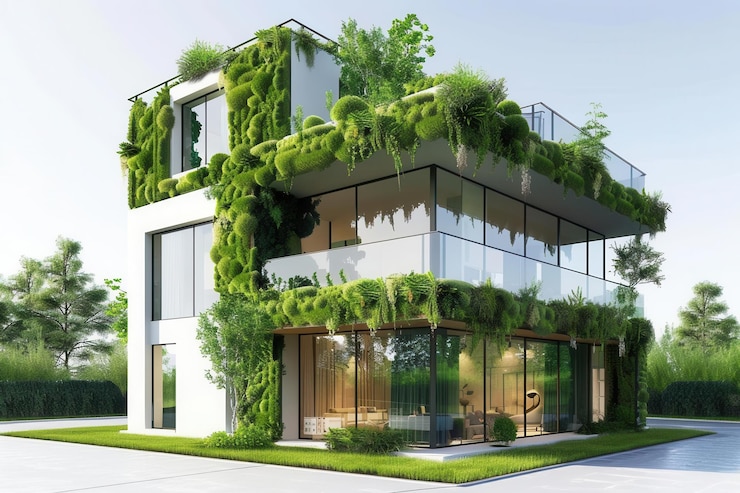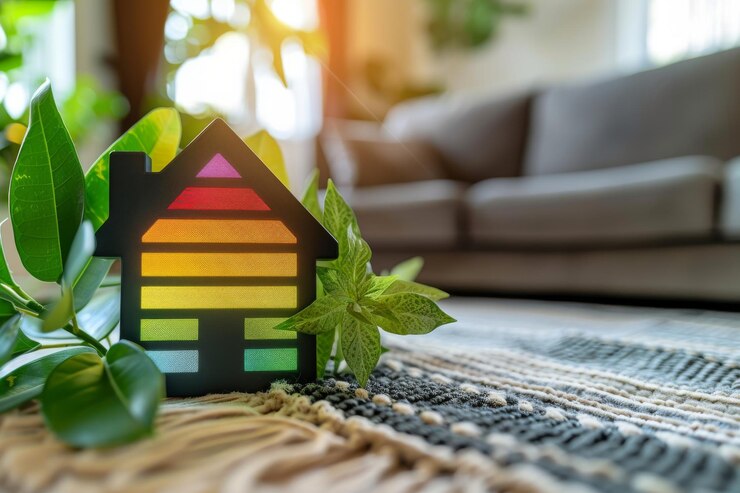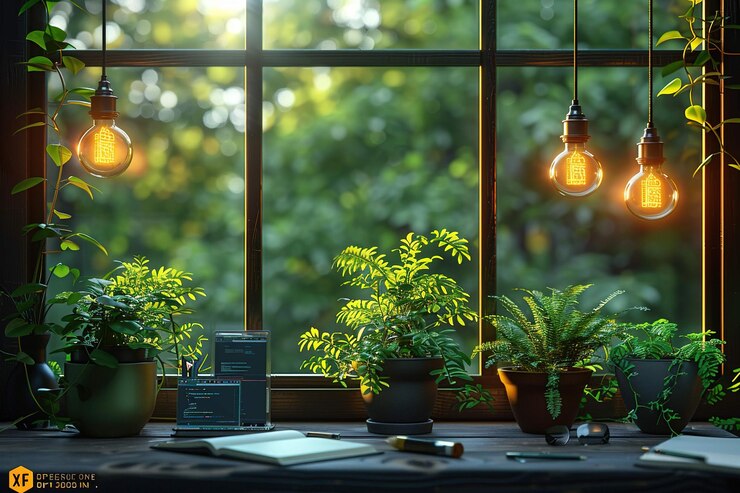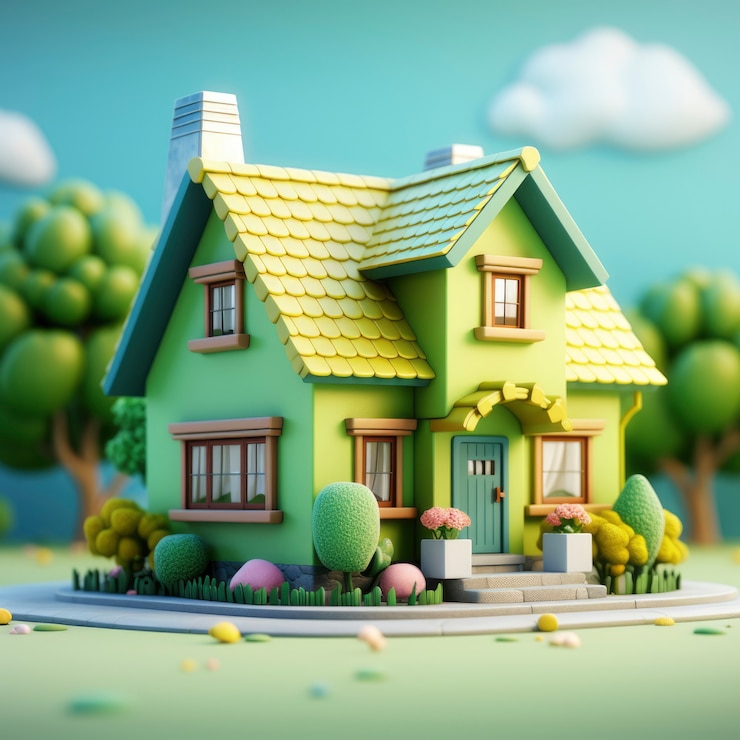Green Home Building is often the most costly purchase people make in their lifetime. The median sales price for a property was $412,000 in 2023. This is a lot of money for most Americans. This cost is so exorbitant that if you bought that home, you would have to spend about 29.5% – 57.9% of your monthly salary repaying the mortgage on the property for the next 20-30 years.
But as onerous as this seems, it is only one component of the realities of owning a property. Basic charges like the home’s electricity bills might build up to a lot of money. But unlike your mortgage this expense is not fixed; it increases. This is why when buying a home, you cannot afford to focus simply on the purchase price of the home and your renovation costs.

You should pay some regard to basic expenses like energy costs. If you can find ways to lower this cost by making your home greener, you will save a lot of money in the long term. What simple actions can you take to make your home greener.
Building new environmentally friendly homes is unquestionably a first step toward carbon neutrality for our country, but because over 80% of the dwellings expected to exist in 2050 have already been built, retrofitting our existing houses is also rather important.
The government recognizes the vital need of eco-retrofits, but as the homeowner you still have to see that the work is done. If you’re keen to increase the effectiveness of your residence.
Top 12 Green Home Building Design for your own construction:
These concepts will not only cut your energy consumption but also make your house more environmentally friendly and help to lessen your whole maintenance expenses.
1. Your home’s position and orientation:
The lot where you build your home and the building’s direction will influence your energy usage. As a rule, west-facing buildings have bigger energy costs due to longer hours of full sun exposure. Buildings in flood-prone areas or earthquake zones also have higher prices.
If the insulation in your house is so poor that heat leaks through the walls, adding renewable energy makes no sense.Any eco-renovation has to involve insulation since inadequate insulation in a house can explain up to 40% of heat loss.
Loft insulation and cavity wall are quite simple.One can utilize a range of materials for this, including sheep wool or expanding foam.Both will cost about £250 to insulate, and the savings on energy bills alone might run about £150 a year.
2. The size of your home:
These days everything is built to be bigger. But a bigger home needs more construction materials and will also require more energy to heat or cool. Avoid redundant spaces in the home; do not add rooms if they will not be filled most of the time.
3. Use earth friendly building materials:
Sustainable building materials are not as easily available as standard building materials and the cost of a green building is often higher than the cost of an ordinary one. But once the building is up, you can recover those costs via massive energy savings.Choosing natural products will help to create a chemical-free house. Your first concerns are floor and interior walls. Walls must be both airtight and permeable if moisture is to flee outside.
Instead of hiding your natural insulation behind man-made walls, let it show. Organic, malleable, and breathable replacements for plasters are clay or lime ones. Wood is the most often used natural flooring even if there are many other kinds available.
Check the provider to guarantee sustainability; the FSC symbol is a quite good indicator. Though always be careful to investigate the supply chain, if wood isn’t your thing you could want to look at 100% natural materials like rubber, marmoleum, or cork.
4. Efficient and green insulation:
Shoddy building methods and inferior materials will only save you money in the short term. If you are looking for ways to cut costs, it should not be in relation to the building envelope. An airtight building is the most important part of your insulation.It goes without saying that you will use a lot of paint to decorate your house. Thankfully, there are lots of eco-friendly things accessible.

The majority of eco-paints are water soluble, with pigments drawn from minerals or plant dyes, and a solution made of plant oils and resins. Green options for wall preparation and cleaning are also available, as are wood varnishes and waxes that are less harmful to the environment. Natural wallpapers made of textiles like wool, cotton, and hessian are examples of sustainable wallpaper.
5. Purchase eco-friendly machinery:
More reasonably priced and accessible than they were years ago are energy-efficient appliances. Any house appliance or piece of equipment bearing the Energy Star designation will drastically cut your energy use. A few communities or businesses even provide incentives for purchasing these products.
6. Think about putting solar panels in place:
To take advantage of solar energy, you need not go totally off-grid. Should the expense of solar panel installation for the complete house be prohibitive, you can run some other systems, water heater, or outdoor lights with solar energy.
Solar panel systems work well with financial incentives like FITs and can be used to generate energy or hot water. Solar photovoltaic (PV) devices use light from the sun to make electricity. You can generate on a cloudy day because they don’t require direct sunlight to work, but you will need to mount them on a wall or roof that faces southward by at least 90 degrees. Prices range from £8,000 to £14,000.
Water-based systems use solar energy to heat domestic water through evacuated tubes or flat plate collectors placed on your roof. If necessary, you can raise the temperature using a backup heater. The majority of hot water cylinder and boiler devices work together. The starting price is £3,000. Depending on the system’s size, you won’t require planning clearance unless you live in Wales or Northern Ireland.
7. Add water-saving elements:
Without compromising your quality of life, water-saving appliances and fixtures enable you to reduce the household water use. Low-flow faucets, toilets and showerheads, or a drip irrigation system are just a few of basic water-saving appliances you might put in your house right now.
Why not gather every year the thousands of liters of rainwater that land on your roof? Gardens can be watered with this water, which also fills washing machines and runs toilets. Imagine a rainwater collecting system with a drainpipe gathering rainfall, a filter removing debris and leaves, and a tank storing the useable water. Think about also upgrading your toilet and shower.
A low-flow showerhead uses less than 10 liters every minute and a low- flush toilet uses less than four liters overall. When George and Rosie Woods bought their old Victorian house, they were keen to transform it into a cozy, useful family home. Find out their approach for their environmentally friendly remodeling job.
8. Ideas for energy-wise friendly gardening:
Shield your house from direct sunshine with shadowing landscaping. Placed around the house, deciduous trees maximize winter sun exposure. Finding trees on the front and southern sides of the house will also help to save energy.
It could be time to change if you have always relied on radiators. Underfloor heating (UFH) is a great alternative for the restoration process that should be easy to install should floors need to be raised.

It runs warm water through a system of cross-linked pipes under your flooring to run at just a few degrees warmer than the surrounding temperature. Its low running temperature makes it possible to link it to other low-temperature output heating sources like solar thermal or heat pumps.
9. Tankless water heater:
A tankless water heater warms the exact amount of water you need at a time. Tank water heaters heat all the water inside them even if you don’t need all of the water. Moreover, the water inside that tank will be warmed several times a day.
10. Energy-saving lighting system:
A mix of energy-saving bulbs and smart systems will help to improve the quality of illumination in rooms, without raising your energy costs. Smart systems will turn off or dim the lights in a room when those rooms are empty, or their occupants are sleeping.
11. Install a cool roof:
Your home’s roof is a big contributor to the building’s energy costs. Because roofs are expansive and exposed to direct sunlight for long times of the day, they play a big role in heating your home. Green roofing materials like slate, terra cotta and white tiles, or a living roof can lower the roof’s impact on your energy bill.
12. Add a controlled thermostat:
Programmable thermostats guarantee that your HVAC systems do not produce more heating or cooling than is actually required. Given that 50% of your home’s energy intake is from heating and cooling, this will reduce your energy bill by a lot.
FAQs:
- How might an eco house be renovated?
- Warm your house.
- Purchase salvaged furniture.
- Install taps designed to save water.
- Change conventional bulbs for LED illumination.
- Apply environmentally friendly paint.
- Acquire a heat pump….
- Put a green roof on top.
- Place sun tunnels.
Which sequence of renovations should you do on a house?
- Usually, most renovations will go this way:
- Strip off and remove.
- Structural work include walls, ceilings, flooring.
- First fix: heating wire and plumbing.
- Plastering flooring.
- Second fix jobs in plumbing, heating, wiring.
- bathroom, kitchens fit-out.











1 thought on “Top 12 Green Home Building Ideas”